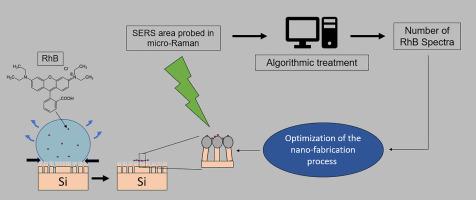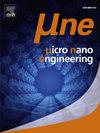Nanofabrication of superhydrophobic fluidic concentrators coupled with metallic plasmonic nano-antennas for SERS analysis in the sub-femtomolar range
IF 3.1
Q2 ENGINEERING, ELECTRICAL & ELECTRONIC
引用次数: 0
Abstract
Self-assembled silicon nanopillars decorated with metallic nanoparticles have emerged as efficient Surface Enhanced Raman Spectroscopy (SERS) substrates. In this study, we combine black Silicon Reactive Ion Etching-Inductively Coupled Plasma (RIE-ICP) and thin film deposition of Silver (Ag) to produce this type of surface equipped with plasmonic nano-antennas. The paper describes a quantitative methodology for optimizing the fabrication process of such silicon SERS supports and specifically the determination of the nominal thickness of the Ag thin film, that upon fragmentation at the surface of the black‑silicon nanopillars, forms Ag nanoparticles capable of enhancing the local electromagnetic field. This parameter is crucial for tuning the surface density of generated hot spots on the surface and their electromagnetic enhancement factors. We propose a methodology based on the generation of hierarchical superhydrophobic fluidic concentrators and the development of a home-made algorithm for analyzing SERS spectra of Rhodamine B (RhB) solution at sub-femtomolar concentrations. The developed hierarchical clustering algorithm automatically selects from all the spectra acquired on the region of interest, the surface enhanced spectra containing at least three vibrational Raman signatures of RhB. The objective criterion for optimizing the fabrication process or for evaluating the performance of any SERS substrate is then simply the total number of RhB spectra finally retained by the algorithm. We detail the fabrication processes, the algorithmic method and through its experimental implementation we show how to tune the parameters of the algorithm for selecting the optimal Ag thin-film thickness.

超疏水流体浓缩器与金属等离子体纳米天线耦合的亚飞摩尔SERS分析的纳米制造
金属纳米粒子修饰的自组装硅纳米柱是一种高效的表面增强拉曼光谱(SERS)衬底。在这项研究中,我们将黑硅反应离子蚀刻-电感耦合等离子体(RIE-ICP)和银(Ag)薄膜沉积相结合,生产了这种类型的表面,配备了等离子体纳米天线。本文描述了一种定量方法,用于优化这种硅SERS支架的制造工艺,特别是确定银薄膜的名义厚度,即在黑硅纳米柱表面破碎后,形成能够增强局部电磁场的银纳米颗粒。该参数对于调整表面上产生的热点的表面密度及其电磁增强因子至关重要。我们提出了一种基于生成分层超疏水流体浓缩器的方法,并开发了一种自制算法来分析亚飞摩尔浓度罗丹明B (RhB)溶液的SERS光谱。所开发的分层聚类算法自动从感兴趣区域获得的所有光谱中选择包含至少三个RhB振动拉曼特征的表面增强光谱。优化制造工艺或评估任何SERS衬底性能的客观标准就是算法最终保留的RhB光谱总数。我们详细介绍了制作过程,算法方法,并通过其实验实现,我们展示了如何调整算法的参数来选择最佳银薄膜厚度。
本文章由计算机程序翻译,如有差异,请以英文原文为准。
求助全文
约1分钟内获得全文
求助全文
来源期刊

Micro and Nano Engineering
Engineering-Electrical and Electronic Engineering
CiteScore
3.30
自引率
0.00%
发文量
67
审稿时长
80 days
 求助内容:
求助内容: 应助结果提醒方式:
应助结果提醒方式:


